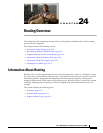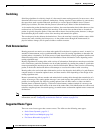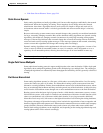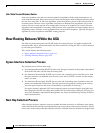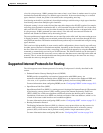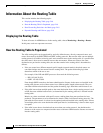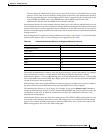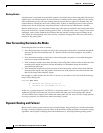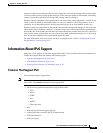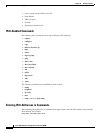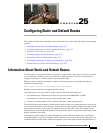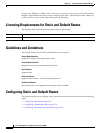
24-7
Cisco ASA 5500 Series Configuration Guide using ASDM
Chapter 24 Routing Overview
Information About the Routing Table
You can change the administrative distances for routes discovered by or redistributed into a routing
protocol. If two routes from two different routing protocols have the same administrative distance,
then the route with the lower default administrative distance is entered into the routing table. In the
case of EIGRP and OSPF routes, if the EIGRP route and the OSPF route have the same
administrative distance, then the EIGRP route is chosen by default.
Administrative distance is a route parameter that the ASA uses to select the best path when there are two
or more different routes to the same destination from two different routing protocols. Because the routing
protocols have metrics based on algorithms that are different from the other protocols, it is not always
possible to determine the best path for two routes to the same destination that were generated by different
routing protocols.
Each routing protocol is prioritized using an administrative distance value. Table 24-1 shows the default
administrative distance values for the routing protocols supported by the ASA.
The smaller the administrative distance value, the more preference is given to the protocol. For example,
if the ASA receives a route to a certain network from both an OSPF routing process (default
administrative distance - 110) and a RIP routing process (default administrative distance - 120), the ASA
chooses the OSPF route because OSPF has a higher preference. In this case, the router adds the OSPF
version of the route to the routing table.
In this example, if the source of the OSPF-derived route was lost (for example, due to a power shutdown),
the ASA would then use the RIP-derived route until the OSPF-derived route reappears.
The administrative distance is a local setting. For example, if you use the distance-ospf command to
change the administrative distance of routes obtained through OSPF, that change would only affect the
routing table for the ASA on which the command was entered. The administrative distance is not
advertised in routing updates.
Administrative distance does not affect the routing process. The OSPF and RIP routing processes only
advertise the routes that have been discovered by the routing process or redistributed into the routing
process. For example, the RIP routing process advertises RIP routes, even if routes discovered by the
OSPF routing process are used in the ASA routing table.
Table 24-1 Default Administrative Distance for Supported Routing Protocols
Route Source Default Administrative Distance
Connected interface 0
Static route 1
EIGRP Summary Route 5
Internal EIGRP 90
OSPF 110
RIP 120
EIGRP external route 170
Unknown 255





